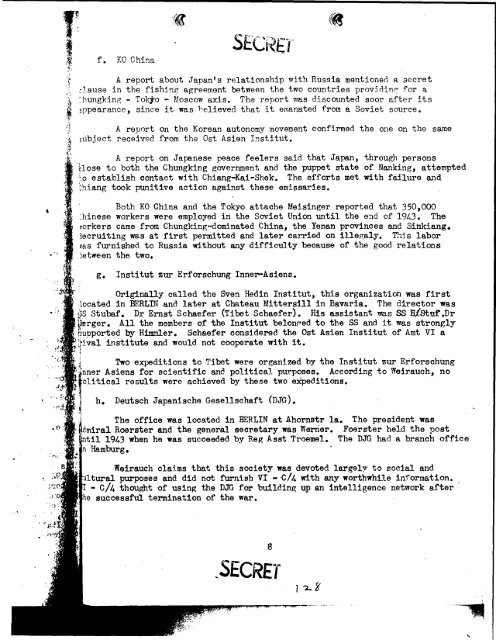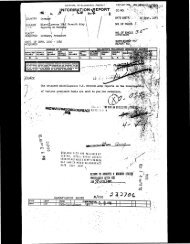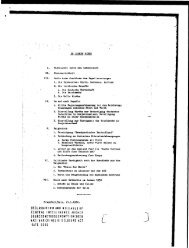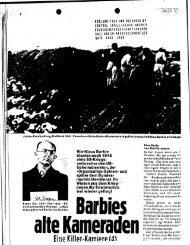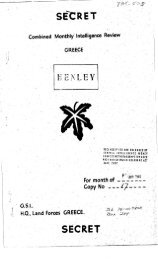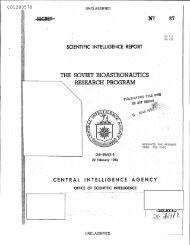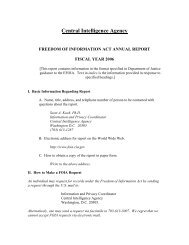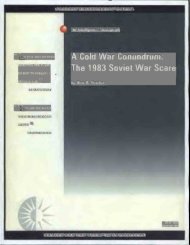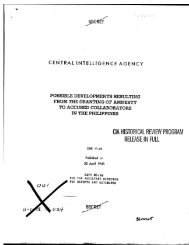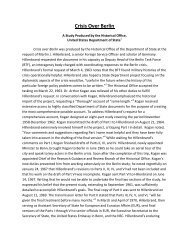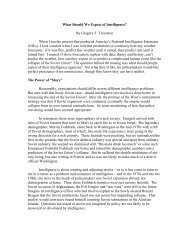RIO 1055 .U51 S-E -C -R--L--T U.S. Army. European Command ...
RIO 1055 .U51 S-E -C -R--L--T U.S. Army. European Command ...
RIO 1055 .U51 S-E -C -R--L--T U.S. Army. European Command ...
Create successful ePaper yourself
Turn your PDF publications into a flip-book with our unique Google optimized e-Paper software.
f. KO China<br />
SECRET<br />
A report about Japan's relationship with Russia mentioned a secret<br />
-l ause in the fishing agreement between the two countries providinr, for a<br />
-hungking - Tokyo - Moscow axis. The report was discounted soor after its<br />
appearance, since it was 1-elieved that it emanated from a Soviet source.<br />
A report on the Korean autonomy movement confirmed the one on the same<br />
subject received from the Ost Asien Institut.<br />
A report on Japanese peace feelers said that Japan, through persons<br />
1ose to both the Chungking government and the puppet state of Nanking, attempted<br />
o establish contact with Chiang-Kai-Shek. The efforts met with failure and<br />
2iiang took punitive action against these emissaries.<br />
Both KO China and the Tokyo attache Meisinger reported that 350,000<br />
.hinese workers were employed in the Soviet Union until the end of 1943. The<br />
Forkers came from Chungking-dominated China, the Yenan provinces and Sinkiang.<br />
3ecruiting was at first permitted and later carried on illegaly. This labor<br />
as furnished to Russia without any difficulty because of the good relations<br />
'petween the two.<br />
g. Institut zur Erforschung Inner-Asiens.<br />
Originally called the Sven Hedin Institut, this organization was first<br />
located in BERLIN and later at Chateau Mittersill in Bavaria. The director was<br />
■SS Stubaf. Dr Ernst Schaefer (Tibet Schaefer). His assistant was SS 8/8tuf.Dr<br />
erger. All the members of the Institut belonged to the SS and it was strongly<br />
mipported by Himm/er. Schaefer considered the Ost Asien Institut of Amt VI a<br />
ival institute and would not cooperate with it.<br />
Two expeditions to Tibet were organized by the Institut zur Erforschung<br />
inner Asiens for scientific and political purposes. According to Weirauch, no<br />
political results were achieved by these two eXpeditions.<br />
h. Deutsch Japanische Gesellschaft (DJG).<br />
The office was located in BERLIN at Ahornstr la. The president was<br />
dmiral Roerster and the general secretary was Werner. Foerster held the post<br />
ti]. 1943 when he was succeeded by Reg Asst Troemel. The DJG had a branch office<br />
n Hamburg.<br />
Weirauch claims that this society was devoted largely to social and<br />
ultural purposes and did not furnish VI - .C/4 with any worthwhile information. .<br />
- thought of using the DJG for building up an intelligence network after<br />
he successful termination of the war.<br />
8<br />
.SECRET<br />
1/4


